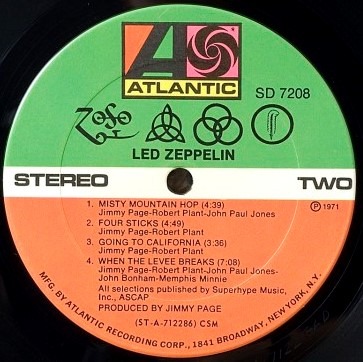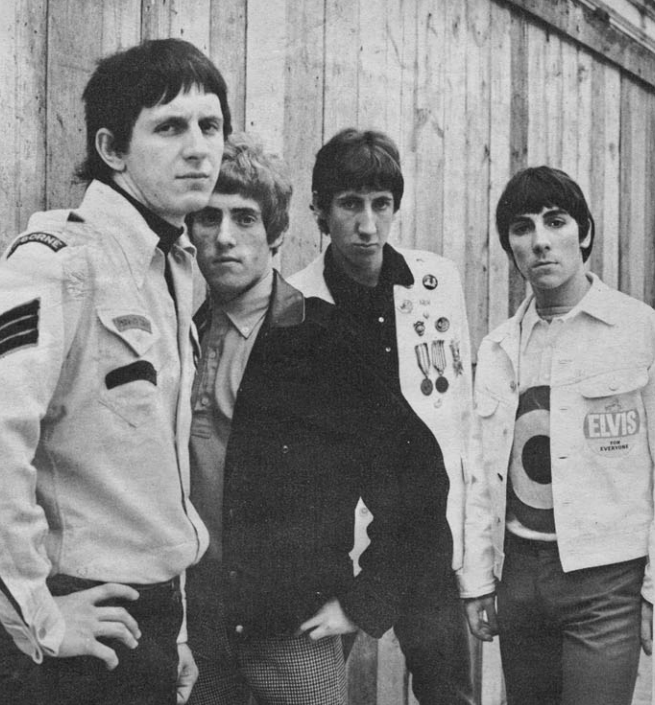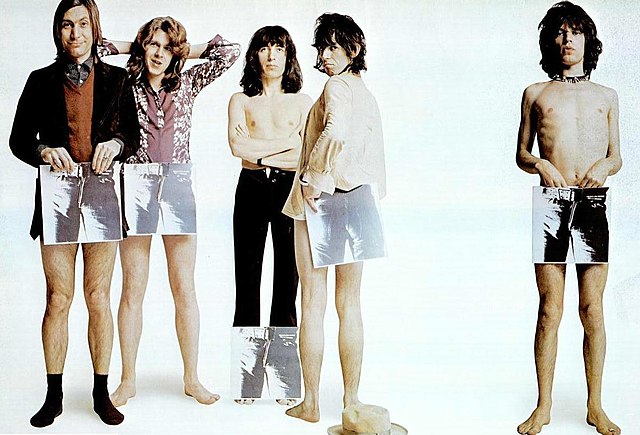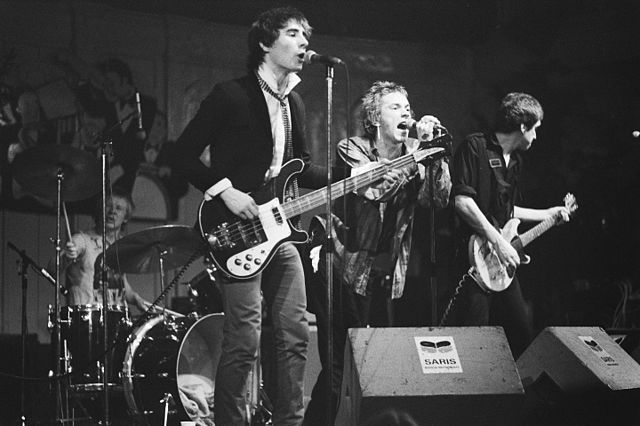The 1970s were a vibrant era for music, especially for British bands who left an indelible mark on rock and roll. This decade saw the rise of numerous influential groups whose innovative sounds continue to resonate today.
Dive into the soundscapes that defined a generation and shaped the course of contemporary music. These ten albums, crafted by the hands of British rock legends, stand as timeless pillars of the 70s music scene.
1) The Dark Side of the Moon – Pink Floyd
“The Dark Side of the Moon” is the eighth studio album by the English rock band Pink Floyd. Released on March 1, 1973, it became a seminal work in progressive rock.
The album was conceived as a concept album focusing on various themes. These themes included the pressures faced by the band and mental health issues. The music combines rock with electronic sounds, creating a unique listening experience.
The popular album cover features a prism dispersing light into a rainbow. This iconic image is still widely recognized today. The album’s success was phenomenal, spending 741 weeks on the Billboard chart.
Tracks like “Money” and “Time” stand out for their innovative use of sound effects and complex time signatures. The lyrics, penned mostly by Roger Waters, delve into deep and thought-provoking topics.
The band members showcase their talents throughout the album. David Gilmour’s guitar work, Richard Wright’s keyboard skills, Nick Mason’s drumming, and Roger Waters’ bass and lyrical genius shine brightly.
“The Dark Side of the Moon” remains one of the best-selling albums of all time. Its influence is evident in many artists and genres. It’s a must-listen for anyone interested in rock music and its evolution in the 1970s.
2) Led Zeppelin IV – Led Zeppelin
Led Zeppelin IV, released in November 1971, is one of the most famous albums from the British rock band Led Zeppelin. The band recorded the album at Headley Grange, a country house, between December 1970 and February 1971.
This album features some of Led Zeppelin’s most well-known songs. “Stairway to Heaven,” an eight-minute epic, stands out as one of the most beloved rock tracks of all time.
Jimmy Page, the band’s guitarist, produced the album. It showcases a mix of hard rock, folk, and blues influences. The album has no official title on the cover, leading many to refer to it simply as Led Zeppelin IV.
The release of Led Zeppelin IV came after their previous album, Led Zeppelin III, received mixed reviews. The band chose to leave the album untitled, letting the music speak for itself.
Tracks like “Black Dog” and “Rock and Roll” are also highlights. These songs helped the album achieve commercial and critical success. Led Zeppelin IV remains a defining work in the rock genre and a must-listen from the 70s.
3) London Calling – The Clash
“London Calling” by The Clash is a landmark album from the late 70s. Released in 1979, it showcases the band’s blend of punk rock with other musical styles like reggae, ska, and rockabilly. The album’s title track captures the band’s energy and biting social commentary.
Joe Strummer’s lyrics often deal with themes of rebellion and political unrest. The tracks incorporate both critique and storytelling, creating a powerful impact. Songs like “Rudie Can’t Fail” and “Train in Vain” highlight the band’s versatility and skill.
The album was produced by Guy Stevens, known for his unconventional methods. His influence helped shape the unique sound of the album. “London Calling” received critical acclaim and has been featured on many “greatest albums” lists.
The album’s cover, featuring Paul Simonon smashing his bass guitar, is iconic. This image represents the raw energy and defiance that defined The Clash. The music continues to resonate with listeners, making it a must-listen album from a pivotal era in British music.
4) Who’s Next – The Who
Released on August 2, 1971, “Who’s Next” is the fifth studio album by the English rock band The Who. The album emerged from the abandoned Lifehouse project, a rock opera that was shelved due to its complexity and internal conflicts.
The recording sessions took place from April to June 1971 at Stargroves and Olympic Studios. The album was associate-produced by Glyn Johns and became the only album by The Who to top the UK charts.
“Who’s Next” includes iconic tracks like “Baba O’Riley” and “Won’t Get Fooled Again,” which showcase Pete Townshend’s ambitious songwriting and the band’s powerful sound. The songs blend rock, early use of synthesizers, and insightful lyrics, making it a seminal work.
The album’s success solidified The Who’s place in rock history and remains a staple in classic rock radio playlists.
5) Breakfast in America – Supertramp
“Breakfast in America” is the sixth studio album by the British rock band Supertramp. Released on March 16, 1979, it captures the band’s transition from progressive rock to a more pop-oriented sound without sacrificing their unique identity.
The album was recorded at The Village Recorder in Los Angeles in 1978. It features a mix of catchy melodies and introspective lyrics.
“Breakfast in America” includes several hit singles. “The Logical Song” reached No. 6 on the US Billboard charts. “Goodbye Stranger” and “Take the Long Way Home” also charted, reaching No. 15 and No. 10 respectively.
In the UK, both “The Logical Song” and the title track were top 10 hits. The album itself achieved widespread commercial success, earning platinum status in the US within four months of release.
Supertramp’s lineup for this album included Rick Davies, Roger Hodgson, John Helliwell, Bob Siebenberg, and Dougie Thomson. Their collective effort resulted in a polished and timeless record.
The album’s cover art is also notable. It features an image of a waitress resembling the Statue of Liberty, holding a menu and a glass of orange juice, symbolizing the American Dream.
“Breakfast in America” remains a standout album from the 1970s, solidifying Supertramp’s place in rock history.
6) A Night at the Opera – Queen
Queen’s fourth studio album, A Night at the Opera, was released on November 28, 1975. It marked a high point in their career, both creatively and commercially. The album featured the groundbreaking track “Bohemian Rhapsody,” which showcased the band’s versatility and creativity.
The album was produced by Roy Thomas Baker and Queen. It was reportedly the most expensive album ever recorded at the time. The title is inspired by a Marx Brothers’ film, reflecting the band’s penchant for blending rock with theatrical elements.
Tracks like “Death on Two Legs” and “You’re My Best Friend” highlight the band’s varied musical influences. Freddie Mercury’s powerful vocals and Brian May’s intricate guitar work shine throughout the album. Each track brings something unique, from rock operas to ballads.
The lyrics of “Death on Two Legs” were notably aggressive, aimed at Queen’s ex-co-manager. The raw emotions and sharp words in the song added to its impact. The album’s innovative approach and diverse range became influential.
From its elaborate production to its eclectic mix of genres, A Night at the Opera stands out as a must-listen album from the 70s.
7) Selling England by the Pound – Genesis
Released in 1973, Selling England by the Pound is a significant album by the progressive rock band Genesis. It is their fifth studio album and marks an important period in the band’s history.
The album includes the iconic track “I Know What I Like (In Your Wardrobe),” which became Genesis’s first top 30 hit in the UK. This song helped propel the band to greater heights.
Peter Gabriel’s theatrical vocal style and imaginative lyrics are prominent throughout the album. The band’s instrumentation complements his delivery perfectly, creating a lush and intricate soundscape.
Songs like “Dancing with the Moonlit Knight” and “Firth of Fifth” showcase the band’s musical prowess. The complex arrangements and proficient musicianship are characteristic of Genesis’s work during this era.
The album reached No. 3 in the UK charts, underscoring its popularity and commercial success. It also managed to make an impact in the United States, reaching No. 70 on the charts.
Genesis’s line-up during this period included Tony Banks, Phil Collins, Steve Hackett, Mike Rutherford, and Peter Gabriel. Each member contributed their unique talents, resulting in a distinctive sound.
Selling England by the Pound remains a cornerstone of 1970s British progressive rock. Its legacy endures, influencing countless artists and delighting fans even decades after its release.
8) The Rise and Fall of Ziggy Stardust and the Spiders from Mars – David Bowie
David Bowie released “The Rise and Fall of Ziggy Stardust and the Spiders from Mars” on June 16, 1972. This album is one of Bowie’s most acclaimed works. It introduces the character Ziggy Stardust, a bisexual, androgynous rocker.
The album blends glam rock with sci-fi themes. Tracks like “Starman” and “Suffragette City” showcase Bowie’s unique style. The band, the Spiders from Mars, was crucial in defining the album’s sound.
Bowie co-produced the album with Ken Scott. Mick Ronson on guitar, Trevor Bolder on bass, and Mick Woodmansey on drums provided strong musical backing. This combination resulted in a powerful and memorable album.
The album cover was created by photographer Brian Ward and artist Terry Pastor. The iconic image of Bowie as Ziggy Stardust set the visual tone for the album. It remains one of rock’s most recognized covers. Bowie’s successful blend of music, storytelling, and imagery makes this album a must-listen from the 1970s.
9) News of the World – Queen
News of the World is the sixth studio album by Queen. It was released on 28 October 1977.
The album contains some of Queen’s most iconic tracks. “We Will Rock You” and “We Are the Champions” have become anthems. These songs showcase Queen’s ability to create powerful rock music.
The album was a move towards a rawer sound. This was different from their earlier, more theatrical works. It was co-produced by the band and Mike Stone.
Tracks like “Sheer Heart Attack” and “Spread Your Wings” highlight the band’s versatility. They capture both hard rock and melodic elements.
News of the World was recorded at Sarm and Wessex Sound Studios in London. The engineering was handled by Mike Stone. The band worked together closely to craft this album.
The album was a mix of popular hits and deeper cuts. Although some tracks were less well-known, they still showcased the band’s talent. It was a significant release in Queen’s career.
10) Sticky Fingers – The Rolling Stones
Released in 1971, “Sticky Fingers” is a standout album by The Rolling Stones. The album marks a significant point in their career, both musically and in terms of its iconic cover design by Andy Warhol.
One of the album’s highlights is its variety. It includes rock, country, and blues influences. Tracks like “Brown Sugar” and “Wild Horses” showcase the band’s versatility and musical range.
“Sticky Fingers” also features the talents of Mick Taylor, contributing to some of the most memorable guitar work. His second appearance on a studio album added depth and complexity to the sound.
The album was produced by Jimmy Miller, known for his work with the band during their peak years. His production helped shape the distinct and polished sound of the record.
63
Influence of British Bands on 70s Music
British bands of the 1970s shaped the music scene with their innovative sounds and cultural influence. Their appearance and music reflected and influenced the social changes of the era.
Unique Sound of the 70s
British bands in the 70s were known for their distinct musical styles. Groups like Led Zeppelin, Pink Floyd, and Fleetwood Mac blended rock with elements of blues, folk, and psychedelia.
Led Zeppelin combined hard rock with blues, creating powerful and energetic music. Pink Floyd introduced progressive rock with experimental sounds and concepts. Fleetwood Mac mixed rock, folk, and blues, releasing iconic albums like “Rumours” in 1977.
These bands pushed musical boundaries, inspiring countless other artists worldwide. Their unique sounds became defining features of 70s music.
Cultural and Social Impact
The cultural and social impact of British bands in the 70s was significant. Their music addressed societal issues and reflected the era’s changing dynamics.
The fashion and lifestyles of bands like David Bowie and The Sex Pistols influenced youth culture. Bowie’s glam rock era and the punk movement led by acts like The Sex Pistols challenged social norms and inspired new fashions and attitudes.
Their bold statements and styles resonated with audiences, making British bands pivotal in shaping the cultural landscape of the 70s.
Innovative Albums: A Deeper Dive
British bands in the 70s set the bar high with their inventive production techniques and compelling storytelling through lyrics. These albums not only sounded different but also conveyed deep and often poignant messages.
Production Techniques
The 70s saw British bands pushing the boundaries of studio technology. Bands like Pink Floyd with “The Dark Side of the Moon” utilized synthesizers and multitrack recording to create a layered, immersive sound. This approach allowed them to explore new audio effects, such as echoes and delays, to add depth to their music.
Black Sabbath’s “Paranoid” introduced a heavier sound through the use of downtuning guitars and powerful, distorted riffs. Queen’s “A Night at the Opera” is another example, where they used complex vocal harmonies and multi-layered recordings. This meticulous attention to production perfection helped them stand out.
The bold experimentation did not stop at instruments. Bands also started experimenting with studio settings, such as acoustic treatments, to change sound dynamics. This period marked a shift where the studio itself became an instrument.








